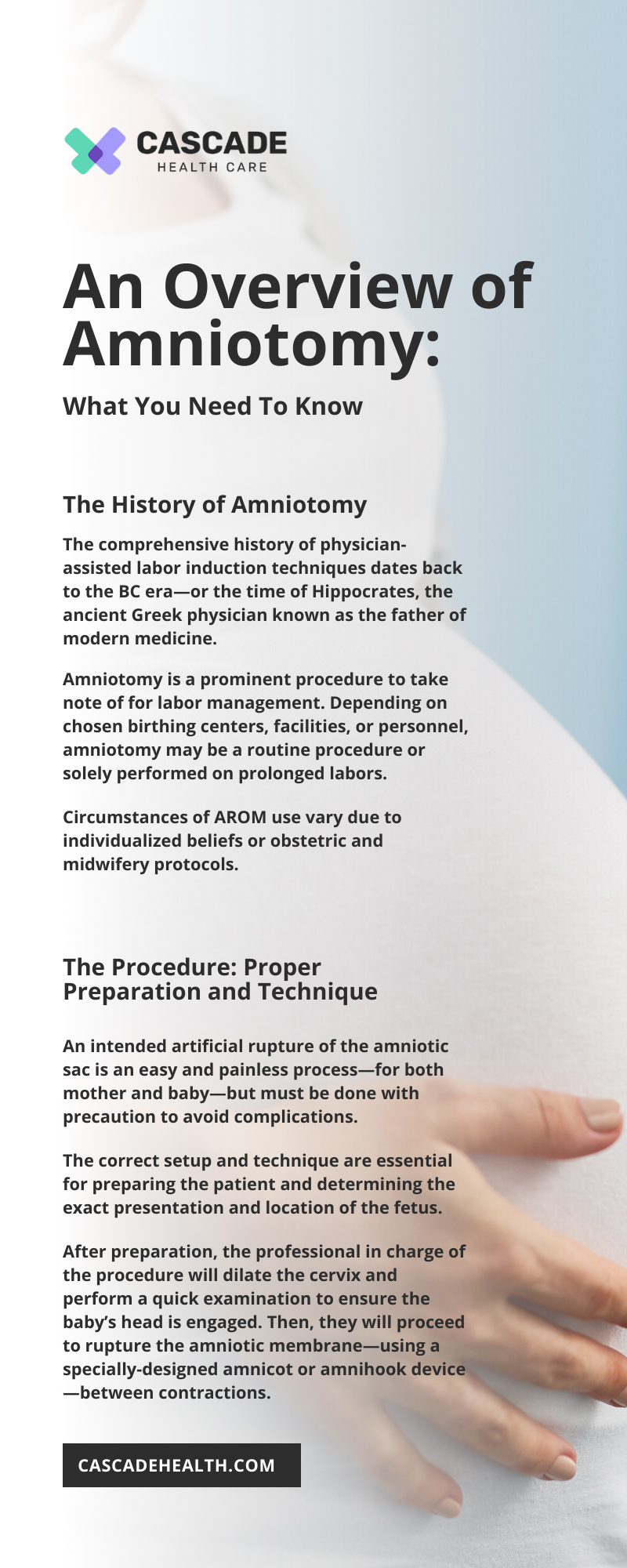An Overview of Amniotomy: What You Need To Know
The intentional artificial rupture of amniotic membranes (AROM)—commonly called the general description “breaking the water”—is a well-known procedure in modern obstetric and midwifery care. Medically known as amniotomy, this standard practice has the primary objective to hasten and strengthen one’s contractions, essentially shortening the duration of ongoing labor.
What exactly does an amniotomy involve? An obstetrician or midwife will use specialized equipment and methodology to release fluid from the amniotic sac. This intervention course of action influences the laboring process physically and chemically. Let’s examine closer what you need to know about this labor-stimulating procedure in an overview of amniotomy.
The History of Amniotomy
The comprehensive history of physician-assisted labor induction techniques dates back to the BC era—or the time of Hippocrates, the ancient Greek physician known as the father of modern medicine. A selection of labor induction and management methods have become commonplace in countries around the globe. In the United States, obstetricians have prevalently employed amniotomy and other mechanical methods to stimulate labor progression and facilitate monitoring for over a century.
Amniotomy is a prominent procedure to take note of for labor management. Depending on chosen birthing centers, facilities, or personnel, amniotomy may be a routine procedure or solely performed on prolonged labors. If not chosen to be performed, the amniotic sac that surrounds the baby typically spontaneously ruptures during the process of active labor.
Circumstances of AROM use vary due to individualized beliefs or obstetric and midwifery protocols. Some contend against this form of intervention because of mixed statistical data and analysis of its effectiveness. All the while, certain situations reveal how this modern medical practice can help protect the mother and baby from specific risks during childbirth.
The Medical Benefits of Amniotomy
Amniotomy may not be ideal for all laboring mothers, yet there are helpful advantages worth noting. A physician, midwife, or medical professional has several possible reasons for artificially rupturing the amniotic membrane during the course of labor, especially in lengthy or high-risk delivery situations.
The main reasons and recommendations include: augmenting stalled labor, inducing labor to shorten time to delivery, fetal electrocardiographic electrode placement to allow internal monitoring, or checking for signs of fetal distress in the amniotic fluid. To attain these medical benefits, an amniotomy procedure can be performed alone or in conjunction with oxytocin.
Making the Decision: Key Signs To Look Out For
The decision to perform an amniotomy is an essential point of discussion in varied birthing and labor management plans. If advised to have an amniotomy, pregnant women should ask questions and discuss the best course of action and expected results with their care providers.
Observable signs indicate whether or not a mom-to-be is ready to—and should—undergo the procedure for successful delivery. In the case of inducing or augmenting labor, the presence of the right conditions is an indication that the procedure is likely to be successful.
A Bishop’s Score
One key determining factor is a Bishop score number. The Bishop score is a widely-used medical system that assesses how an expectant mother’s body prepares for labor and childbirth. Before an obstetrician or midwife intentionally breaks open the sac to release amniotic fluids, they will calculate an estimation of the favorability of the cervix based on diameter, position, firmness, etc.
This exam assesses various aspects to calculate a score number, such as the position and consistency of the baby and cervix dilation and effacement changes. A score of 8 or higher indicates a favorable cervix for a vaginal birth, while anything less than 6 is not ideal for an induced or augmented amniotomy.
Contraindications, Complications, and Criteria
Every pregnancy, labor, and delivery experience is different. As a medical term, contraindications relate to specific situations or factors that make a procedure potentially inadvisable for a particular individual. With amniotomy, there are certain concerns determined through ultrasounds or vaginal exams. These contraindications include a lack of an engaged head, abnormal presentation, or the presence of vasa previa.
With the condition that a mother has a favorable cervix—and the baby’s head is engaged—amniotomy has relatively few risks or complications. Some potential or unintended adverse effects include umbilical cord prolapse, infection, vaginal bleeding, injury, fetal blood loss, or the baby turning breech.
To best avoid maternal and fetal stressors, the standard criteria required for amniotomy are a patient without contraindications for vaginal delivery, a patient in labor or indicated ready for delivery, and a baby with a fully-engaged head.
The Procedure: Proper Preparation and Technique
Next up in an overview of amniotomy: what you need to know is a brief summary of the procedure itself. An intended artificial rupture of the amniotic sac is an easy and painless process—for both mother and baby—but must be done with precaution to avoid complications.
An obstetrician or medical professional performs an amniotomy in a labor room or delivery room, with the expectant mother in a semi-sitting recumbent position in bed. The correct setup and technique are essential for preparing the patient and determining the exact presentation and location of the fetus.
After preparation, the professional in charge of the procedure will dilate the cervix and perform a quick examination to ensure the baby’s head is engaged. Then, they will proceed to rupture the amniotic membrane—using a specially-designed amnicot or amnihook device—between contractions. Once opened, they must gradually control the flow of the amniotic fluid to prevent umbilical cord prolapse. The physician or midwife will note and measure characteristics of the fluid while the labor team continues monitoring throughout the entirety of the birthing process.
Equipment Commonly Used for Amniotomies
Amniotomy requires assorted tools and supplies for successful completion in clinical settings. The list of equipment for this procedure includes the following items.
- A high-grade amniotomy hook or finger oct to rupture the sac
- Sterile gloves and lubricant for an efficient process
- Personal protective equipment to protect the health care team
- Absorbent towels or pads for use under the patient
- An electronic fetal monitor, if required
Cascade Health Care: Who We Serve
Cascade Health Care carries a variety of professional medical tools and products, including high-quality amniotic hooks for performing amniotomies. Whatever your needs are, we’re here to supply the necessary equipment and help provide the best standard of care. Our team proudly serves medical professionals and consumers to enhance health care team and patient outcomes.

Recent Posts
-
5 Applications for Dopplers in Endocrinology
Doppler ultrasound technology has transformed diagnostic capabilities across multiple medical specia
-
5 Medical Instruments Used During IUD Procedures
Intrauterine device insertion requires proper technique and the right medical instruments to ensure



